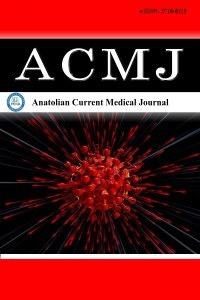Base excess, bicarbonate, and lactate levels predict 28-day mortality in patients with COVID-19: a retrospective study
Base excess, bicarbonate, and lactate levels predict 28-day mortality in patients with COVID-19: a retrospective study
COVID-19, base excess bicarbonate, lactate, mortality,
___
- Lu H, Stratton CW, Tang YW. Outbreak of pneumonia of unknown etiology in Wuhan, China: The mystery and the miracle. J Med Virol 2020; 924: 401-2.
- Zhu N, Zhang D, Wang W, et al. A Novel Coronavirus from Patients with Pneumonia in China, 2019. N Engl J Med 2020; 3828: 727-33.
- WHO Coronavirus Disease (COVID-19) Dashboard. Access address: https://covid19.who.int/ Access date: 06/08/2021.
- Huang C, Wang Y, Li X, et al. Clinical features of patients infected with 2019 novel coronavirus in Wuhan, China. The Lancet 2020; 39510223: 497-506.
- Paules CI, Marston HD, Fauci AS. Coronavirus Infections-More Than Just the Common Cold. Jama 2020; 323: 707–8.
- Corman VM, Landt O, Kaiser M, et al. Detection of 2019 novel coronavirus (2019-nCoV) by real-time RT-PCR. Euro Surveill 2020; 253: 2000045.
- Liu Y, Yang Y, Zhang C, et al. Clinical and biochemical indexes from 2019-nCoV infected patients linked to viral loads and lung injury. Sci China Life Sci 2020; 633: 364-74.
- Bezuidenhout MC, Wiese OJ, Moodley D, et al. Correlating arterial blood gas, acid-base and blood pressure abnormalities with outcomes in COVID-19 intensive care patients. Ann Clin Biochem 2021; 582: 95-101.
- Güven BB, Ertürk T, Yıldız E, Durmayüksel E, Ersoy A, Tanoğlu A. Our convalescent plasma experiences in COVID-19 patients hospitalized in the intensive care unit. J Health Sci Med 2022; 5: 600-6.
- Güngörer B. Baseline demographic, clinical and laboratory risk factors for predicting admission to intensive care unit in patients diagnosed with COVID-19 in the emergency department. Anatolian Curr Med J 2021; 3; 279-83.
- Kara U, Şimşek F, Özhan MÖ, et al. The factor analysis approach to mortality prediction in COVID-19 severe disease using laboratory values: a retrospective study. J Health Sci Med 2022; 5: 528-33.
- Bennouar S, Bachir Cherif A, Kessira A, et al. Usefulness of biological markers in the early prediction of corona virus disease-2019 severity. Scand J Clin Lab Invest 2020; 808: 611-8.
- Diagnosis and Treatment Protocol for Novel Coronavirus Pneumonia (Trial Version 7). Chinese Med J 2020; 1339: 1087-95.
- Prokop M, Everdingen Wv, Vellinga TvR, et al. CO-RADS: a categorical CT assessment scheme for patients suspected of having COVID-19—definition and evaluation. Radiology 2020; 2962: E97-E104.
- Dong Y, Zhou H, Li M, et al. A novel simple scoring model for predicting severity of patients with SARS-CoV-2 infection. Transbound Emerg Dis 2020; 676: 2823-9.
- Izcovich A, Ragusa MA, Tortosa F, et al. Prognostic factors for severity and mortality in patients infected with COVID-19: A systematic review. PLoS One 2020; 1511: e0241955.
- Yang L, Jin J, Luo W, Gan Y, Chen B, Li W. Risk factors for predicting mortality of COVID-19 patients: A systematic review and meta-analysis. PLoS One 2020; 1511: e0243124.
- Guan W-j, Ni Z-y, Hu Y, et al. Clinical Characteristics of Coronavirus Disease 2019 in China. New England Journal of Medicine 2020; 38218: 1708-20.
- Bruno RR, Wernly B, Flaatten H, et al. Lactate is associated with mortality in very old intensive care patients suffering from COVID-19: results from an international observational study of 2860 patients. Ann Intensive Care 2021; 111: 128.
- Dheir H, Karacan A, Sipahi S, et al. Correlation between venous blood gas indices and radiological involvements of COVID-19 patients at first admission to emergency department. Rev Assoc Med Bras (1992) 2021; 67: 51-6.
- Kieninger M, Sinning A, Vadász T, et al. Lower blood pH as a strong prognostic factor for fatal outcomes in critically ill COVID-19 patients at an intensive care unit: A multivariable analysis. PLoS One 2021; 169: e0258018.
- Türkay Kunt A, Kozaci N, Torun E. Mortality predictors in patients diagnosed with COVID-19 in the emergency department: ECG, laboratory and CT. Medicina (Kaunas) 2021; 57: 629.
- Asghar MS, Haider Kazmi SJ, Khan NA, et al. Poor prognostic biochemical markers predicting fatalities caused by COVID-19: a retrospective observational study from a developing country. Cureus 2020; 128: e9575.
- Bonetti G, Manelli F, Patroni A, et al. Laboratory predictors of death from coronavirus disease 2019 (COVID-19) in the area of Valcamonica, Italy. Clin Chem Lab Med 2020; 587: 1100-5.
- Yayın Aralığı: 6
- Başlangıç: 2019
- Yayıncı: MediHealth Academy Yayıncılık
Cardiac effects of Sugammadex and Rocuronium combination in rats: experimental study
Mevlüt DOĞUKAN, Nezir YILMAZ, Ebru ANNAÇ, Zümrüt DOĞAN, Fatih ÜÇKARDEŞ, Öznur ULUDAG
Systemic immune inflammation index: is it a new marker for contrast-induced nephropathy?
Zafer ERCAN, Mehmet Emin DEMİR
Clinicopathological evaluation of our patients with ultrasound assisted percutaneous kidney biopsy
Tamer SELEN, Mehmet Deniz AYLI, Gülay ULUSAL OKYAY, Hatice ŞAHİN, Elif KAHRAMAN GÜNER, Kadir Gökhan ATILGAN, Fatma AYERDEN EBİNÇ, Ebru GÖK OĞUZ, Arzu SAĞLAM, Onur ERGUN
A retrospective look at influenza during the COVID-19 pandemic
Sigmoid colon duplication seen as a rare cause of ileus in adult: case report
Barış BAYRAKTAR, Salih BOLUK, Sümeyra Emine BÖLÜK
The effect of malignancy on prognosis in ICU patients with COVID-19
Elmas UYSAL, Fatih SEĞMEN, Gamze KILIÇARSLAN, Deniz ERDEM
Outcomes of patients with COVID-19 pneumonia treated with moderate and high dose corticosteroids
Murat KAYA, Hayati KART, Oytun Derya TUNÇ, Samed ÇATAL, Ömer BÜYÜKTOPÇU, Evrim ŞİRİN
